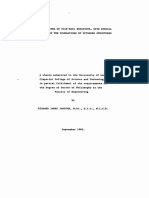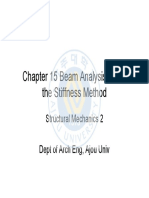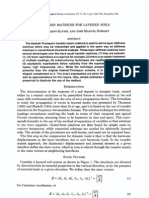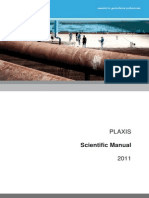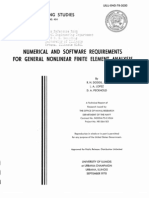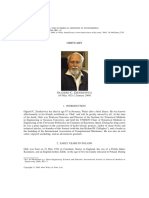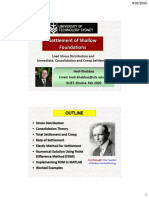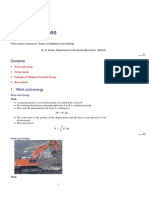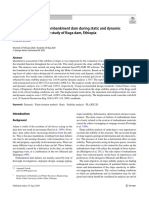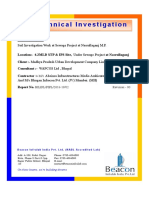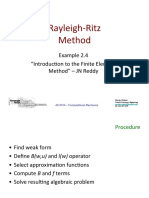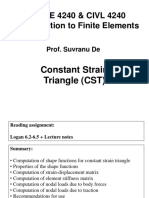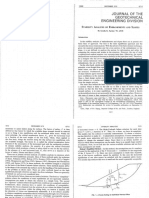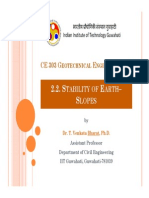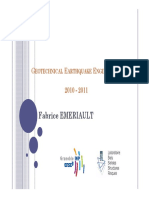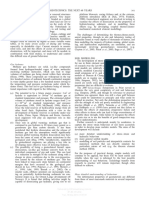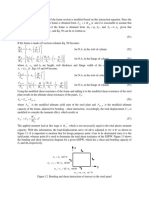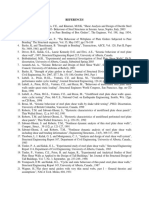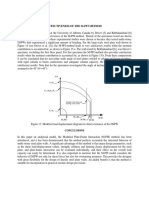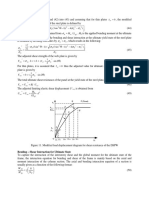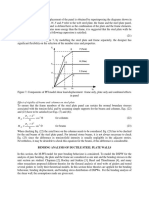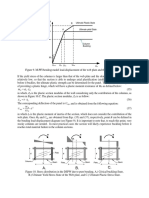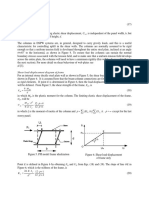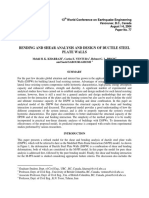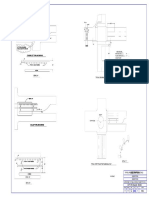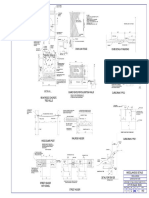0 ratings0% found this document useful (0 votes) 397 views8 pagesNon Linear Finite Element Analysis of Safety Factor
Brinkgreve, Bakker (1991) nonLin FEA SF
Copyright
© © All Rights Reserved
We take content rights seriously. If you suspect this is your content,
claim it here.
Available Formats
Download as PDF or read online on Scribd
PROCEEDINGS OF THE SEVENTH INTERNATIONAL CONFERENCE ON COMPUTER,
METHODS AND ADVANCES IN GEOMECHANICS / CAIRNS /6- 10 MAY 1991
Computer Methods and Advances
in Geomechanics
Edited by
G.BEER
CSIRO, Division of Geomechanics
J.R.BOOKER & J.RCARTER
University of Sydney
OFFPRINT
Ns
Published on behalf of the International Association for Computer Methods
and Advances in Geomechanics by
A.A.BALKEMA / ROTTERDAM / BROOKFIELD / 1991�Computer Methods and Advances in Geomechanics, Beer, Booker & Carter (eds)
‘© 1991 Balkema, Fotterdam. ISBN 906191 1893,
Non-linear finite element analysis of safety factors
R.B.J.Brinkgreve
Delft University of Technology, Netherlands
HLL. Bakker
Public Works Department, Netherlands
ABSTRACT: In this paper a robust method is proposed to determine the safety factor of
geotechnical constructions
in finite element computations.
The method 1s based on the
SeSuction of the strength parameters of soil, the friction angle # and the cohesion c.
Three examples show the practical application of the method.
1 INTRODUCTION
In structural engineering a factor of
safety 1s always defined as the ratio of
the collapse load over the the working
load. The same definition is adopted in
foundation engineering, at least for
footings and piles. For soil bodies such as
road/river enbanknents and earthen dams the
situation is different. Here the dominating
load is not a direct external force, but
most of the load cones from soil weight
Very cohesive soil bodies can be loaded to
collapse by increasing gravity, either
numerically or in centrifuge tests, but not
when the strength 1s dominated by friction.
Therefore other definitions of safety are
connon in soll mechanics. The usual soil
mechanics definition of safety is:
S _ eto'tan
safety factor = -§-* “ES er tane,
where S is the shear strength, further
defined by the well known Mohr-Coulomb
criterion, Note that c is the cohesion, #
is the friction angle and o’ is the normal
pressure at the plane considered. Both c
and ¢ are effective strength parameters and
o” is an effective stress. We use the
subscript ¢ to indicate critical strength
paraneters; Just high enough to ensure
equilibrium. Indeed, for c=c, and g=p_ the
safety factor becomes equal to unity. The
above definition of safety coincides with
the classical definition as used in slip
circle analysis on the condition that we
define:
1417,
ef tang, = ae / tang with ast
In this study the proportionality with
will be retained in order to remain
compatible to traditional slip circle
analysis, but the method allows for other
ratios of c. and tané,.
‘This study concentrates on the computation
of the above safety factor by use of an
elastic-plastic finite element method. In
‘stead of the usual incrementation of loads,
strength parameters will be decremented.
This technique was first proposed by
Zienkiewicz at al. (1975), but we make the
Procedure robust by adding an arc-length .
technique. A robust procedure was needed
for implementing into the PLAXIS finite
element package. Finally the potential of
‘the method is demonstrated by considering a
number of applications.
2 MOHR-COULOMB MODEL,
Being interested in collapse loads rather
than precise deformations, the
elastic-plastic Mohr-Coulomb model 1s
adopted. Hence
x
1 oy,
B adgeep eee�The symbols f and g are used to denote the
yleld function and the plastic potential
function respectively. Considering planar
deformations only, with the x-y-coordinates
in the plane and the 2-axis normal to the
plane, we define
fer-(ccotp+e) sing
get-o sing
where
Ce (oto)
we Sy’ 2a? yy!
For the sake of convenience, it is assumed
that the out-of-plane stress ois in
between the principal stresses o-t and c+.
3 IMPLICIT INTEGRATION
Finite element analyses involve finite
increments of stress and strain rather than
rates as considered above. Several
integration rules can be applied to pass
from rates to finite increments. One of the
most popular ones, as first proposed by
Vermeer (1979) and most recently by BorJa
& Lee (1990), 1s the implicit integration
schene. Here the direction of flow 1s
considered to be fully determined by the
state of stress at the end of a load
Ancrenent. Denoting finite increnents by
the symbol A and t for time, we get
. 28 ay = 28 a8
as sa Mare Bsra- fo
where
f° = flo + D be)
where @'ls the stress at the beginning of
the load increment. Details are given by
Vermeer & Van Langen (1989). Having defined
the increment of plastic strain as a
function of the total strain Increment,
is easy to compute the stress increment
from:
at
an
D (ae ~Be?)
4 FINITE ELEMENT FORMULATION
We consider a soil body subJect to constant
gravity and constant external loads. These
are equilibrated by a known stress field
@°. Hence, the finite element equilibrium
Conditions give:
1118
¢
Fig. 1. Increnents for strength-reduction
SBer a
where both body forces and external loads
are assembled in the vector Q for nodal
forces. We now apply a decrement of the
strength parameters, so that the yield
locus rotates as indicated in Fig.1.
Obviously, the new stresses ¢ (without
superscript) will be at the new yield
locus, at least for material points with
stresses ¢° above this line. Let us now
define
= 9° bot bo®
9
4g7= D (Ae ~he")
where 9°+ 4g" is the closest point
projection of @° on the new yield surface.
Substitution in the equillbrium equation,
and using ¢= Bu, gives:
K ou = RY AR + P
where K is the elastic stiffness matrix and
1,
aR =~ tg" Jy BD Me? av
In practice R° will not entirely vanish
because of numerical procedures; separation
fron AR 1s important for later formulation
of an arc-length control procedure. P is a
pseudo load vector, ae used within an
initial-stress iteration-procedure of the
We adopt an initial stress procedure since
a tangent stiffness procedures tend to
break down in the fully plastic range due
to 111-conditioning.�en
5 INDIRECT DISPLACEMENT CONTROL,
The above strength reduction procedure is
is far from being robust. Indeed, by a step
wise decrease of strength it 1s possible to
approach collapse, but for some step the
strength will be reduced too much, i.e.
beyond critical, so that the iterative
procedure will not converge to an
equilibrium state of stress. In this manner
the precise critical values of tang and c
are never obtained. Therefore indirect
displacement control is needed, or in other
words arc-length control (Rheinboldt &
Riks, 1986). Within this approach we add a
load multiplier 8, and obviously an extra
scalar equation for solving B. The system
of iteration equations is
K out = Res ata + PR
aut ast = au? au,
The subscript 1s used to denote results
fron the previous load step. Instead of the
node displacement vector of the previous
step, other vectors can be used to obtain a
Linear scalar equation for 8. Similarly
non-linear equations are feasible.
6 STABILITY OF RIVER EMBANKMENT
‘The first practical application involves a
river embanknent in the tidal zone. The
slope has a horizontal length of 10 m and a
height of Sm, so the ratio is 1:2. The
most dangerous situation for a embanknent
4s at the onset of low tide. The waterlevel
outside the embankment 1s already low, but
the phreatic level in the embankment is
still high. The situation, which is
modelled 1s shown in Fig. 2. We consider a
homogeneous soll with material properties
as Indicated in Table 1.
Fig. 2. River embankment at low tide
1119
Table 1. Soll properties for embankment
Parameter ‘Symbol | Value
Dry weight % 16.0 KN/n?
Wet weight 1 20.0 kN/m?
Friction angle ’ 30.0 °
Cohesion e 5.0 kPa
Shear modulus G 1000 KPa
Poisson’s ratio | v 0.3
In the first part of the analysis we apply
the soil weight to introduce the stresses
for the situation of Fig. 2. Some of the
Gaussian integration points appear to be in
plastic state already, but the embankment
has not collapsed at all
In the second part of the calculation we
want to analyze the safety of the
construction. Therefore we apply ten steps
in which the strength parameters of the
soil are stepwise reduced, according to the
theory as described before. When further
reduction of the strength parameters in not
possible anymore, the construction has
collapsed and the safety factor is
obtained. Fig. 3 shows the computed
strength-displacement curve for the crest
point of the embankment The value of the
safety factor for this particular problem
appears to be 1.20,
strength reduction
Diaplacenents crest point * 0.1
Fig. 3. Strength-displacement curve
Fig. 4 shows a plot of the incremental
‘displacenent contours at failure. In this
plot one can recognize a nice slip circle.
In the same plot the critical slip circle
according to Eishop’s method is plotted,
Note that we performed a drained analysis
both for the finite element approach and
the Bishop approach.�Fig. 4. Incremental displacement contours
Whilst the positions of the slip circles
are sonevhat different, the safety factor
in both Bishop's method and the finite
elenent calculation 1s exactly the sane.
This gives sone validation of the proposed
method. It might now be concluded that the
calculation of the safety factor in finite
element codes has no advantage in
comparison with conventional methods. In
this simple case this happens to be true,
but the finite element method will also
detect non-circular slip surfaces and
associated factors of safety. The next
examples will show that in general the
finite elenent calculation of the safety
factor gives information that cannot be
obtained with conventional methods.
7 STABILITY OF A SHEET-PILE WALL
For the second application we consider the
safety of an excavated building trench. The
excavation depth is 21 m. The soll is
supported by 32 m long sheet-pile walls,
which are strutted at the top. During the
excavation of the soil the water table
remains at a constant level, both inside
and outside the trench. Fig. 5 shows the
finite element mesh of the trench. Special
Line elements, as available in the PLAXIS
Fig. 5. Mesh for building trench
sheet-pile wall (Bakker & Brinkgreve,
1990). The dashed lines in Fig. 5
Andicate Joint elements to model reduced
friction at the soil-structure interface
(Van Langen & Vermeer, 1990).
The soil is mostly fine silty sand with
sone clay layers. In fact it consists of 7
layers, which correspond to the element
layers in the mesh of Fig 5. The material
properties for each layer are given in
Table 2. Layer No. 1 is the top layer and
layer No. 7 is the lowest layer. For the
sheet-pile wall and the strut ve used:
Tynest = 1:65 x 10° Nn?
A F
lanes, 7 8:04 x 10° kN/m
erat’ b= 1:28 x 10% kN/a?
:
Table 2. Properties for different layers
%|% | @/[e] ¢
Paver) ml ed]
wave) Na wpa | KPa
1 | 18.0 | 20.0 | 30.0 [1.0 | 6000
2 | 16.0 | 16.0 | 25.0 | 8.0] 3000
3 20.0 | 32.5 | 0.0 | 6000
4 20,0 | 32.5 | 0.0 | sooo | |
5 20.0 | 32.5 | 0.0 | 25000 | }
6 18.0 | 27.5 | 4.0 | 9500
7 20.0 | 32.5 | 0.0 | 15000
The soil which is to be excavated, is
modelled by external loads: horizontal
tractions simulating the horizontal
stresses at the sheet-pile wall and
vertical tractions simulating the vertical
stresses at the bottom of the trench.
The calculation consists of 3 parts. The
first part 1s the introduction of the
initial stresses including the tractions on
the sheet-pile wall and the trench bottom.
‘The second part is the excavation of the
trench by stepwise removing the external
loads. Bending moments and strut forces
occur in this part of the calculation.
There is a stress reduction directly behind *
the sheet-pile wall mainly due to arching
(Bakker & Brinkgreve, 1990). The extrene
horizontal displacement of the sheet-pile
wall 1s about 100 mn. The extreme bending
moment amounts 2100 kNa/m and the strut
force is 500 kN/m. Fig. 6 shows a plot of
the incremental displacement contours at
service state. A concentration of contour
Lines can be regarded as the initialisation
of a shear band,
1120�Fig. 6. Velocity contours at service state
The third part of the calculation is the
determination of the safety factor by means
of strength reduction. According to this
calculation, the safety factor appears to
be 1.65. The development of the bending
moments during this calculation part is
remarkable, as the clasping moment
disappears and the sheet-pile wall tends t
behave like a beam on two supports (Bakker
& Brinkgreve, 1991).
Fig. 7 shows a plot of the incremental
displacenent contours at collapse. This
plot visualizes a slip line going from the
right-hand top, underneath the sheet-pile
wall to the middle of the trench bottom. I
comparison with the service state the slip
Line has moved drastically downwards.
Fig. 7. Velocity contours at failure
‘8 EMBANKMENT STABILITY WITH GEOTEXTILE
The third application involves the safety
of a road embankment. The embankment has a
height of 6 m. In this example two
situations are modelled: Firstly an
Fig. 8. Geometry of road embanknent
ordinary case where the embankment is build
Just on top of the underground and secondly
With the addition of a geotextile
underneath the embankment. The situation is
shown in Fig. 8,
The so11 consists of four layers. The top
layer is the embankment fill material. The
underground consists of two clay layers
with a layer of soft peat in between. The
Soil properties are given in Table 3.
Table 3. Properties for different layers
ealccaleon cae
al ae oe %
pavn?hrave?] + | wre | ue
1 |rs.0 [isc fas.o | 2.0 | soo
a | 2 liste fisce fac | £0 | 500 Jo.co
3 fitce lire [isco | 2:0 | aso fo-rs
4 fisce [tae [2ao | 5:0 | 800 foceo
Again the analysis consists of 3 parts. The
first part 1s the introduction of the
initial stresses in the underground. As the
underground is horizontal the initial
stresses can directly be derived from the
soil weight and the K,-values given in
Table 3.
The second part of the calculation is the
building of the embankment. At the end of
this part the top of the embankment shows a
settlement of 68 cm (without geotextile)
and 66 cm (with geotextile). The geotextile
seens to have Little influence so far.
‘The third part is the calculation of the
safety factor. Now the differences between
both situations are much more apparent. In
the case without geotextile the safety
factor 1s less than 1.20 while in the case
with geotextile the safety factor is over
1.30. In practice, only the latter
situation 1s acceptable.
1124�The difference in safety factor between the
two situations is due to the fact that the
failure mechanisms are completely
different. Fig. 9 and 10 show plots of the
incremental displacement contours of both
situations. In the first case the failure
nechanism is a slip circle going through
the soft peat layer. In the second case the
same mechanism is initially developed, but
this is resisted by the geotextile.
Collapse finally occurs in the embanknent
itself.
Fig.9. Velocity contours without geotextile
Fig. 10.Velocity contours with geotextile
Considering the results it would seem that
geotextiles have an effect on stability
rather than on deformation, but this will
depend on the relative stiffness of the
geotextile. For the present application we
used EA = 2500 kN/n.
‘9 CONCLUDING REMARKS:
The proposed finite element method for the
determination of the safety factor by means
of strength reduction gives results which
agree well with those from Bishop’ s
slip-circle method, at least for simple
situations when a circular surface occurs.
The advantage of the method in comparison
with conventional methods is that it even
deals with the most complex kind of
geotechnical constructions. Besides one
does not have to predefine the failure
mechanism.
Arc-length control makes the procedure
robust since failure need not be associat
with a non-converging iterative procedure.
Moreover the arc-length procedure gives th
full strength-displacenent curves beyond
possible peaks.
REFERENCES
Bakker, K.J. & Brinkgreve, R.B.J. 1990. The,
use of hybrid beam elements to model
sheet-pile behaviour in two dimensional
deformation analysis. In Proc. II Eur.
‘Spec. Conf. on Num. Meth. in Geotech.
Eng., p-559-571. Santander, CEDEX
Bakker, K.J. & Brinkgreve, R.B.J. 1991.
Deformation analysis of a sheet-pile
wall, using a two dimensional model. In
Proc. X Eur. Conf. on Soil Mech. and
Foundation Eng., Florence
Bor Ja, R.I. & Lee, S.R. 1990. Cam-Clay
plasticity, Part I: Implicit integration
of elasto-plastic constitutive relations.
In Comp. Meth. in Appl. Mech. and Eng,
Vol 78, p.49-72
Rheinboldt, W.C. & Riks, E, 1986. Solution
techniques for non-linear finite elenents
equations. In State-of-the-art surveys on
finite element techniques, p. 183-223. New
York, Appl. Mech. Div. of ASME
Van Langen, H. & Vermeer, P.A. 1990. Finite
element analysis of a pile penetration
problem in clay. In Proc. IT Eur. Spec.
Conf. on Num. Meth. in Geotech. Eng.,
p.519-527., Santander, CEDEX
Vermeer, P.A. 1979. A modified initial
strain method for plasticity problems. In
Proc. III Int. Conf. on Num. Meth. in
Geonech., p.377-387. Rotterdam, Balkema
Vermeer, P.A. & Van Langen, H. 1989. Soil
collapse computations with finite
elements. In Ingenieur-Archiv 59, p.
221-236
Zienkiewicz, 0.C., Humpheson, C. & Lewis,
R.W. 1975. Associated and non-associated
visco-plasticity and plasticity in soll
mechanics. Géotechnique 25, No. 4,
p.671-689)�Beer, G.,J.R.Booker & J.PCarter(eds.) 906191 1893,
‘Computer methods and advanees in geomechanics ~ Proceed-
ings of the seventh international conference, Cairns, 6— 10 May
1991
1991, 25 m,¢.2000 pp., 3 vols., H.385 /$210.00/£122
‘Computer methods have become a powerful tool for solving prob-
lems in geomechanics & geotechnology. For example, in mining
‘civil engineering these methods have lead to improvements in
design and are now applied to such diverse problems as rock
‘mechanics, geophysics, geological engineering, ice mechanics,
blasting & environmental geotechnology. The proceedings present
the latest intemational research onthe application of numerical
1 thods to problems in geomechanics & on advances in constitu-
tive modelling of geomaterials. In addition, new measurement &
monitoring techniques & analytical methods ae presented. Topics
range fro. environmental to resource geotechnology including
rock mechanics, geophysics, geological engineering, blasting,
flow problems & more. Significant contributions are included on
‘CADiexper systems, groundwater geomechanics, back analysis
experimental studies.
FROM THE SAME PUBLISHER:
906191 809 X
in geomechanics: Innsbruck 1988
Proceedings ofthe sith international conference, Innsbruck, 1! =
1S April 1988
1988-89, 25 cm, 2378 pp.,4 vols, H.450/$250.00 /£142
Main lectures; Numerical techniques & programming
tive laws of geotechnical materials; Flow & consolidation; Ice
‘mechanics; Rock hydraulics; Modeling of joints, interfaces &
discontinuumm; Modeling of infinite domains; Soil-structureinter-
action ples: Earth structures, slopes, dams, embankments; Tun
nels & underground openings; Dynamic & earthquake engineer-
ing problems, blasting: Mining applications; Interpretation of field
icrocomputers; Cad, mesh gene-
Dungar,R. & J.Studer (eds.) 906191518X
‘Geomechanical modelling in engineering practice
1986, 25 cm, 409 pp, HA.185 /$100.00 /£58
‘The Key to successful solution of problems by the finite element
‘method lies in the choice of appropriate numerical mod-
‘ls & their associated parameters for geological media. 16 invited
contributions from wellknown authorities from USA, UK, Swit
zerland, Japan && Canada on: Basic concepts; Nu
‘merical modelling of selected engineering problems; Specific mu-
‘merical models & parameters evaluation.
Kotkman, PA.,J.Lindenberg & K.W.Pilarczyk (eds.)
906191 8154
Modelling soil-water.structure interactions - SOWAS 88—
Proceedings ofthe international symposium. Delt
29.08-02.09.1988
1988, 25 cm, 514 pp., HA.150/$85,00/£47
Soil-water-structure interactions; Wave and current induced
‘behaviour ofthe seabottom: Local scour; Behaviour and stability
‘of block revetments and filter layers; Wave impact loads and
‘behaviour of asphalt revetments; Pils, platforms, piers and grav-
ity structures; Sand suppletion processes and flow slides; Break-
waters, dams and walls. Miscellaneous.
Balasubramaniam, A.S..etal (eds) 906191 8642
Computer and physical modelling in geotechnical engineering
Proceedings ofthe international symposium, Bangkok, 3-6 De-
cemiber 1986
1989, 5 em, 550 pp. HA.190/$105.00/£60
Stability of natural & man made slopes: Design & design of
foundations; Underground openings & excavations: Computer
controled testing & investigation of soils; Data acquisition &
‘management in geotechnical engincering; Computer aided solu-
tions for some special problems in engineering. 47 papers.
Ervin, MC. (ed) 906191 5066
In-situ testing for geotechnical investigations - Extension
course, Sydney May-June 1983
1983, 25 cm, 140 pp., HA.100/$55,00/£32
‘An introduction to new developments, methods & applications of
in-situ testing. 9 papers by Australian practising engineers & uni-
versity lecturers. Editor: Coffey & Parmers, Melbourne.
‘Alemayehu Teferra & Edgar Schultze 906191 8049
Formulae, charts and tables in the areas of soil mechanics and
foundation engineering- Stresses in soils
Formeln, Tafeln und Tabellen aus dem Gebiet Grundbau und
Bodenmechanik — Bodenspannungen
1988, 25 cm, 300 pp.,HA.95 /$50.00/£30
‘This handbook is the result of many years of arduous work of |
systematically collecting the scattered scientific literature that is
highly valuable to students and practicing engineer in the fields of
soil mechanics and foundation engineering. The merit ofthe hand-
‘book lies not oly inthe compilation of important information that
isnormally not easily accessible to students and practicing en-
gineers, but also in the provision of adequate illustrative examples
‘that will facilitate the application of te formulae, charts and
tables. n onder to give the user the additional possibilty torefer to
the original works, references are given atthe end ofeach topic.
Elastic-sotropic half-space (Surface; Loads in half-space); Two
layers Vertical surface loading (Point loads; Line loads; Strip
loading; Uniformly distributed rectangular loads; Axial symme-
tric loads; Loading with any shape; Stresses at interface), Multiple
layers (Stresses at interfaces; Circular uniform loading). Authors:
‘Addis Ababa University & German Academic Exchange,
Joshi, R.C. & F.Griffiths (eds.) 9061917077
Prediction and performance in geotechnical engineering —
Proceedings ofan international symposium on prediction and,
performance in geotechnical engineering, Calgary, 17-19
June 1987
1987, 25 cm, 464 pp.,H.150/ $85.00 /£47
Invited papers; Prediction & performance of pile foundations; Soil
improvement; General prediction & performance of soils, unique
soils, retaining structure behaviour & tunnels; Environmental geo-
technology: Triaxial testing of soils; Centrifuge model testing;
Risk analysis. 51 papers
Spencer, A.J.M. (ed) 906191 6828
‘Continuum models of discrete systems ~ Proceedings ofthe fifth
international symposium, Nottingham, 14=20 July 1985
1987, 25 cm, 248 pp., Hf, 145 /$80.00 /£46
Recent developments in the study of material behavior, with part-
cular emphasis on the dificult but important problems of relating
‘behavior on the microscopic scale to that on the macroscopic
scale. Authors were specially invited. 29 papers,
All books available from your bookseller or directly from the publisher:
AA Balkema Publishers, P.O.Box 1675, Rotterdam, Netherlands
For USA & Canada: A.A, Balkema Publishers, Old Post Rd, Brookfield, VI, USA



